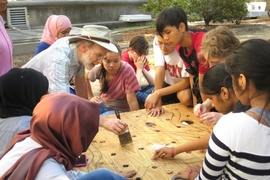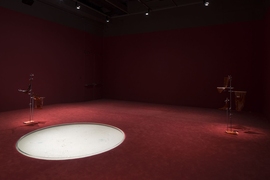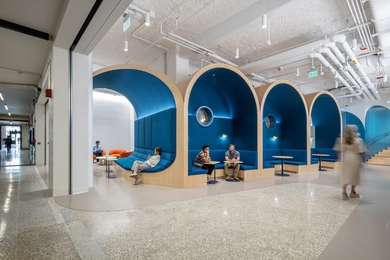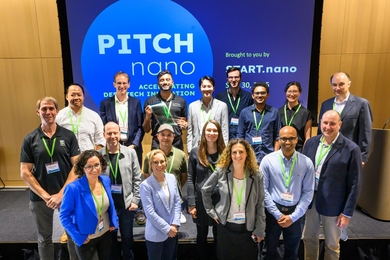Should design suit current human needs or be imagined for the future? This was the core topic of debate at the close of the MIT Media Lab’s first design summit, Knotty Objects.
With a dose of sardonic wit, guest speakers Ahmed Ansari and Jamer Hunt took to the stage for an impassioned philosophical debate on “affirmative design” (designs that reaffirm a status quo) versus “critical design” (challenging a status quo). In this thrilling denouement to the two-day event, Ansari and Hunt argued their positions and left the "knotty" matter fittingly unresolved.
From July 15 to 16, the event convened designers, scientists, authors, and curators at the Institute of Contemporary Art (ICA) in Boston and the MIT Media Lab to explore design at the intersection of science, engineering, and cultural production. The event was co-organized by Paola Antonelli, senior curator of architecture and design and director of research and development at the Museum of Modern Art; Neri Oxman, the Sony Corporation Career Development Associate Professor of Media Arts and Sciences; and Kevin Slavin, the Benesse Career Development Assistant Professor of Media Arts and Sciences.
In her introduction, Oxman said, “This is a very exciting time for design — a time when we’re creating objects by knotting disciplines in contexts that are technologically savvy and culturally sensitive.” "Knotty" objects, she added, permanently entangle practices, processes, and policies — and their conception, design, manufacturing, and usage are ambiguous.
The organizers chose four archetypal knotty objects — brick, steak, phone, bitcoin — as lenses through which to examine the transdisciplinary nature of contemporary design. The event’s four sessions — “The New Metabolism,” “New Dimensions in Organic Design,” “Manufactured Objects,” and “Design and Complexity” — explored the intricacies of building, food, communication, and commerce.
The occasion also marked the first ever MIT Media Lab Award, which, according to the event's webpage, “celebrates individuals who break new grounds by refusing to acknowledge separate territories of design, science, and technology.” This honor was bestowed upon Anthony Dunne and Fiona Raby in a spectacular opening event at the ICA, where Dunne and Raby delivered the keynote address for the design summit to a packed house.
Dunne and Raby coined the term “critical design” to describe the speculative practices that they have employed in their 30-year careers as designers and as faculty in the Design Interactions Programme at the Royal College of Art in London. They use design to stimulate discussion and debate about the social, cultural, and ethical implications of existing and emerging technologies. It is their view that products — unlike philosophy, literature, and art — can bring the conversation to the wider public.
In their keynote address, Dunne cited his and Raby’s manifesto, "A/B," which outlines their future-oriented design aspirations: “We’re taught to design for how the world is now, whereas we believe we need to imagine how the world could be and design for that.” Although, "a lot of our designs are aimed at our minds and our belief systems,” Dunne noted, visually arresting projects — such as a blood bag shaped like a teddy bear or futuristic car designs — demonstrate their commitment to giving material expression to their concepts.
Dunne and Raby’s contribution to design was woven throughout the event, as 26 speakers linked design philosophies, technology, and other things.
Brick: the new metabolism
In the first session, “The New Metabolism,” bricks were shown to be more than mere mortar — they can be made of mushroom mycelium, corn, circuits, and potentially DNA. They can also unite digital and biological materials. The speakers in this session — David Benjamin, an architecture professor at Columbia University; George Church, a professor of genetics at Harvard Medical School; Nicola Twilley, a contributing writer for the New Yorker; and Hashim Sarkis, dean of MIT's School of Architecture and Planning — discussed how bricks’ traditional attributes of modularity and assembly could be combined with ideas about interconnectedness, growth, and metabolisms.
For example, Benjamin discussed his projects, which reimagine architecture through synthetic biology and treat cities as living organisms with their own kind of "metabolisms." Sarkis connected these ideas to the work of the Metabolists, post-war Japanese architects who fused ideas about megastructures with biological growth. Giving the example of a soccer ball, Sarkis said social networks create the need for objects (like a soccer ball) and, in turn, objects possess the ability to connect social networks.
In her discussion of a “Knotty Metabolism,” Oxman investigated the interconnectedness of things. She described the chain of events caused by the explosions of the 1954 U.S. nuclear test at Castle Bravo and how “the Cold War gradually made it through the food chain, and Carbon-14 made its way into the human DNA." She also discussed a wearable digestive system created in her MIT lab, where two microorganisms were engineered to have a symbiotic relationship.
Steak: new dimensions in organic design
“The steak knots together so many interesting issues and touches the deepest recesses of our humanity,” Antonelli said in her introduction to “New Dimensions in Organic Design.” The panelists — Kevin Esvelt, a technology development fellow at Harvard University; Isha Datar, executive director of a biotech startup; and Daisy Ginsberg, an artist and entrepreneur — addressed the taboos and unresolved issues surrounding steak, animal slaughter, and the use of in vitro cells to produce food products. The moderator, freelance curator Alexandra Midal, for instance, cited an early study that warned that destroying animals by the millions could neutralize the act of killing and have unpredictable consequences for human nature.
The ethical implications of meat production were paramount to Esvelt's and Datar’s presentations. In his talk on biological design, Esvelt addressed such topics as resurrecting extinct species, spreading synthetic traits to wild populations, and editing human DNA for engineered offspring. He pointed out that there are historical precedents for sculpting living things by directing evolution — such as genetically engineering larger livestock or selectively breeding wolves to produce chihuahuas — before introducing the current biological design dilemma: “We could alter mosquitoes so they could no longer spread disease … alter crop pests so that they no longer have a taste for eating our crops, or even control invasive species. We could do all that by speaking nature’s language and using biology rather than bulldozers and toxic chemicals, but the question of course is, 'Should we?'”
Molecular biologist Datar, who produces animal products without animals at New Harvest, discussed the threats to animal life (including humans) and the environment posed by the current factory farming system, which produces 60 billion land animals annually to serve the needs of roughly 6 billion people on Earth. “The way we make animal products is still absurd,” she said, suggesting that growing complex organisms for simple tissues is grossly inefficient. She warned that continuing to design animals based on human preferences will lead to more complex ethical dilemmas, such as whether to make chickens unconscious while we farm them to alleviate their suffering.
Phone: manufactured objects
Our phones, with regular updates and ability to track our preferences, are reminders that an object is no longer divorced from the manufacturer once it's in consumers’ hands. The panelists in “Manufactured Objects” — Tanya Menendez, co-founder of a maker startup; Anab Jain, co-founder of a design startup; and artist Revital Cohen — discussed the shifting relationship among designers, manufacturers, and consumer.
Jain discussed some of the work produced at her startup, Superflux, including a collaborative project with neuroscientists to create retinal prostheses that allow blind people to see in areas of the electromagnetic spectrum outside the visible spectrum, and a purposely provocative project that uses open-source software to scan cellphones for potential Transportation Security Administration "trigger words," which are then displayed on badges worn by the users. Not all Superflux’s projects, however, are provocations: They have also designed portable air quality sensors that attach to baby carriages to record data. "We understand things by building them, by getting under the hood of the technology," Jain said.
Cohen, an artist whose work deals broadly with materials and manufacturing, presented several of her pieces, including "75 Watt," for which she worked with a choreographer and 15 assembly line workers at a Chinese factory to make a product that had no other function than to choreograph the workers’ movements. Interested in the "design and manufacture" of animals, Cohen also worked with a biologist in Japan to make a goldfish with no reproductive organs. Her latest obsession is the mining industry, where she takes old electronics and reverse engineers them to extract gold, aluminum, and other precious metals — which she then crafts into rocks.
Bitcoin: design and complexity
Bitcoin, data visualization, mathematical games, and lacemaking were a few topics addressed in “Design and Complexity.”
In his remarks, Joi Ito, director of the Media Lab, tackled Bitcoin, saying, “The Internet could have been a very boring medium, had designers and entrepreneurs not thrown their creativity at it. I think now Bitcoin is in a very similar space.” Beyond being merely digital currency, Ito stressed that Bitcoin could be something bigger if creative people get an intuitive sense of “the nitty-gritty of Bitcoin and its ancillaries.”
Alan Chochinov, a surgical device designer who taught himself tatting (making knotted lace), spoke of the gendered complexity of making doilies, as well as the social and utilitarian complexity of making tens of thousands of knots. Lacemaker Scott Page spoke about complex systems from a scientific perspective.
Artist and designer Fernanda Viégas presented several data visualizations, such as her striking editorial history of Wikipedia, which exhibits the patterns that emerge with mass deletions and editing wars. Another project, “Seeing the wind,” replaced the static arrows of former wind maps with motion graphics. As Viégas said, “by making the visual image more complex, it is easier to understand.”
Debate: critical design versus affirmative design
Prior to the debate on critical design versus affirmative design, audience members were asked to show allegiance to one philosophy or the other by a show of hands. After Hunt and Ansari argued their positions, some opinions shifted (again by a show of hands). In her closing remarks, Oxman suggested that perhaps new categories — such as “critical-affirmative” or “affirmative-critical” — can account for many who have more nuanced design principles. Then, borrowing a line from famed comedic actor Groucho Marx, she added, “If you don’t like my principles, I have others.”
The event concluded with open-ended discussion and ongoing debate. As predicted by the organizers at the beginning of the event: there was no conclusion.














